Dauria gets involved in a large microsatellite race
In the global private satellite industry today there has been an obvious trend, which can be expressed by the phrase “remove per day”. Several young companies at once expressed their readiness to create low-cost satellite constellations to take pictures of a place on Earth once a day. Many investors believed in the business success of such an idea, and companies were actively pursuing implementation. Among them was the Dauria Aerospace created in Russia
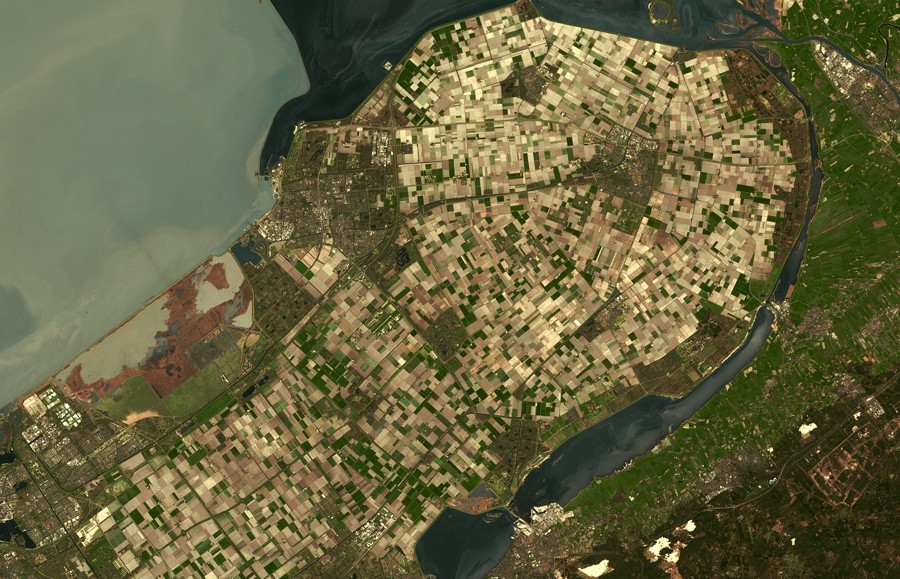
The previous race of private Earth remote sensing satellites was conducted for resolution, and it already rested on physical and legal limits. Now the satellites of the Digital Globe company can see details on the surface of the Earth up to 30 cm in size. In order to remove even better, the creators of the Hubble telescope need to be repeated, and so far no one has decided. In addition, in the United States, civilian distribution of images with a resolution higher than 50 cm is prohibited by law, and since most of the customers are from there, no one wants to achieve greater sharpness. Detailed images of cities in Google Maps have already been obtained by aerial photography.
')
It seemed that there was no place to develop further, but then someone suggested: “Let's shoot a little worse, but more often”. The American company from Silicon Valley SkyBox Imaging took seriously the implementation of this idea. She plans to launch 24 SkySat satellites, the size of a washing machine that can take pictures of specified points on Earth once a day with a resolution of about 1 meter. The first unit flew in December 2013, the second one flies this summer.
The unique ability of these satellites is the ability to record video for up to 90 seconds.
For the best effect, expand to full screen.
The first two SkyBox machines were made by themselves, and now they decided to concentrate on managing and applying the shooting results. In March, another 13 SkySat orders went to Space Systems / Loral, a satellite company.
On a par with SkyBox, another startup from San Francisco, Planet Labs, was developing. I first learned about them when I saw their old site, decorated with pictures from the Russian Electro-L apparatus. At first, their idea was like some kind of self-indulgence: to launch several dozen nanosatellites 10x10x30 cm into orbit. They had to shoot the surface of the Earth with a resolution of 5-10 meters, and also very often.
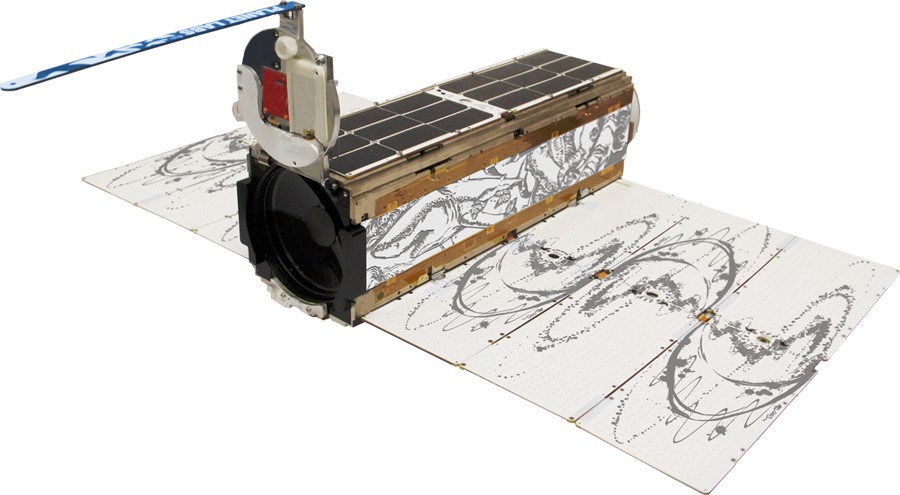
In 2013, the tests of the first Dowe (“Dove”) series devices were successful. It turned out to shoot at least a few shots, which confirmed the capabilities of the devices. And in early 2014, a whole dovecote from 28 satellites was brought to the ISS. And some of them are already running.
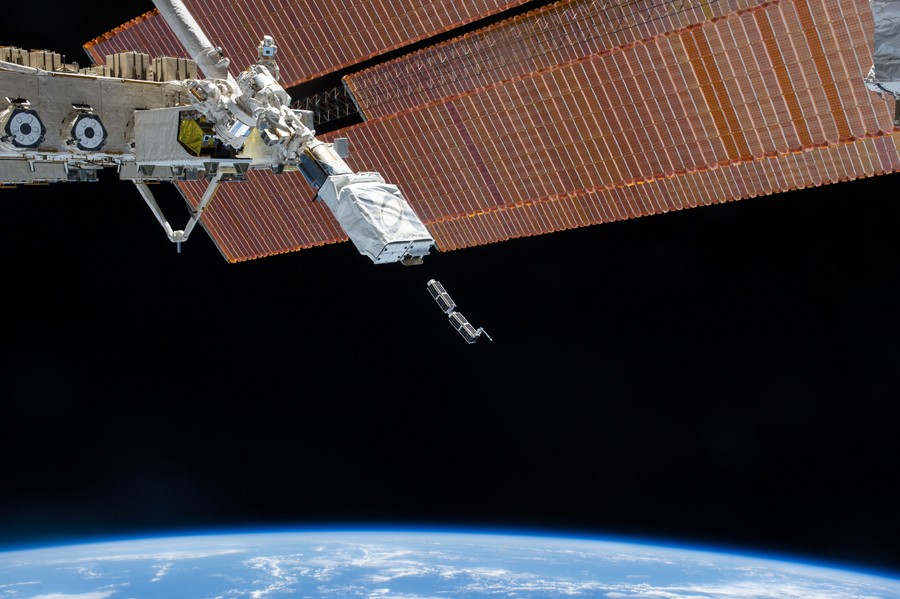
The peculiarity of the ISS orbit is such that the station never flies over the poles, so Planet Labs, even with so many satellites, cannot promise coverage of the entire Earth. But in their plans there is at least one more launch of a group of satellites into the polar orbit, then their capabilities will become much wider. Recently they declared that they are ready to launch only 131 satellites, i.e. their devices will become the largest satellite constellation in the world.

At the end of April 2014, the international company Dauria Aerospace , founded by Russian businessmen, declared its ambitions for a resolution of 22 meters. The goal is the same: take off for the day. But if SkyBox is ready to provide daily updates of pictures of one or several points, then Dauria claims the whole land. All continents of the Earth will be able to shoot every two days, and the territory between the fortieth parallels - every day. This goal is supposed to be realized by the Dauria grouping of eight Perseus-O satellites together with the Spanish Deimos 1 spacecraft from Elecnor Deimos .
Deimos 1 is flying for the fifth year. The company that created it has a wealth of experience in obtaining, processing and commercializing data from it.
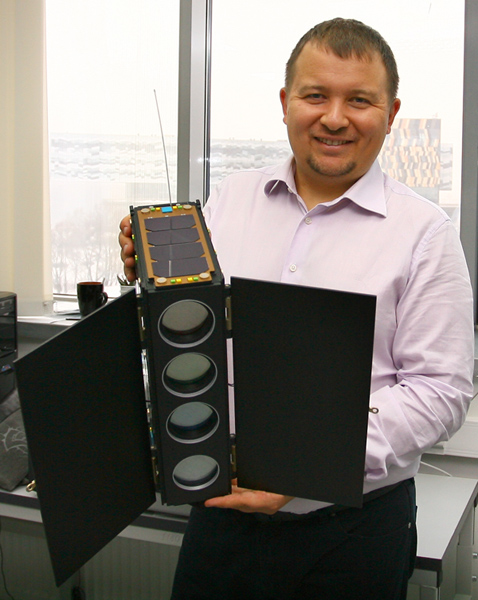
Founder of Dauria Aerospace, Mikhail Kokorich with a dimensional model of Perseus-O .
Perseus-O is developed and built by Dauria. It is several times smaller than Deimos 1, and constructively they are not connected in any way. They only have the quality of the data they receive. They shoot in the multispectral range. In fact, this means that they take color shots, but the difference between ordinary cameras and satellites is that they do not use the same color channels that our eyes are used to. Instead of red, green, and blue (known to many RGB), satellites "see" green, red, and near infrared. This allows you to get more information about the surface, and therefore earn more on it.
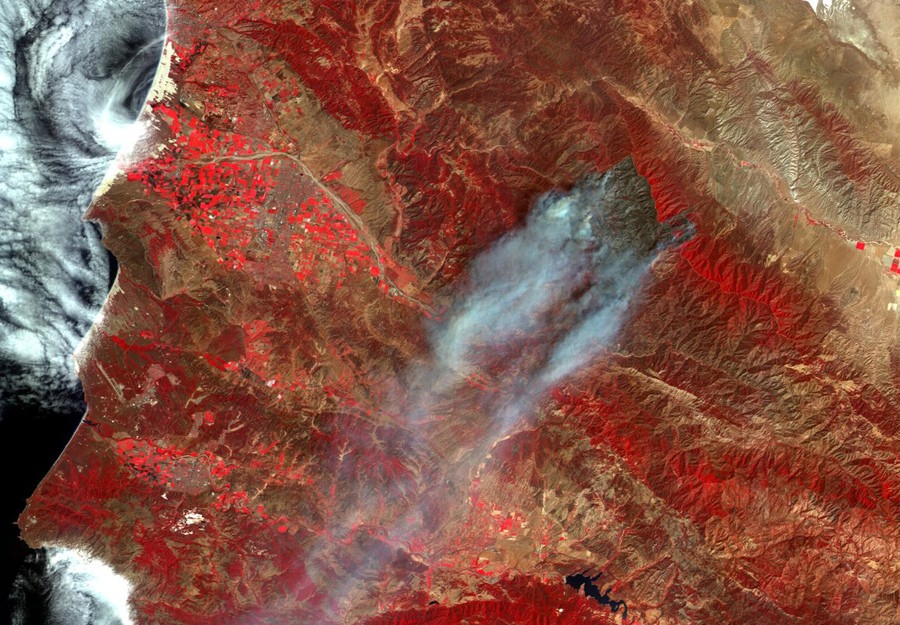
Fire in the forests of California in 2009. Pay attention to the bright pink rectangles of the fields.
To date, many algorithms for processing images and obtaining information from them have been developed. One of the most visible and frequently used - NDVI (Normalized Difference Vegetation Index). It is based on the ability of chlorophyll to reflect infrared light much more than visible. Thanks to him, it turns out to observe a subtle difference in the growth and development of green spaces, it is possible to determine signs of a lack of moisture in the soil, foci of possible infections in the fields and forests. Accordingly, any identified problem can be solved and, thereby, protect agricultural companies and forest services from losses. NASA and the US Geological Survey use the NDVI index for global monitoring of vegetation throughout the planet.
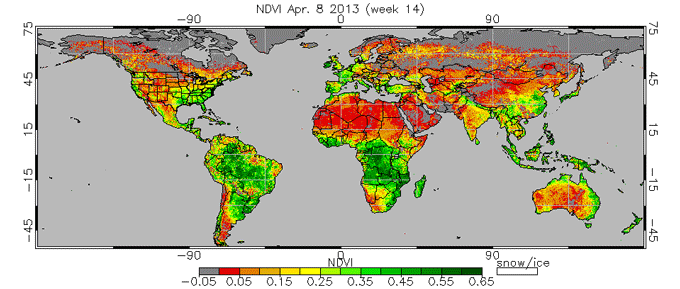
What is unique in the satellites of Dauria Aerospace?
They are small and they are cheap (by space standards). Once it was difficult to imagine that a satellite the size of a portfolio would be not just a “beeper”, but a full-fledged spacecraft with practically full functionality of multi-tone satellites.

Perseus-O have a control system based on flywheel engines and magnetic actuators, which allow you not only to look down and take what you see, but to work in various shooting modes, including at an angle to the surface up to 20 degrees. This provides the ability to cover the entire surface of the continents of the Earth for two days, and some specific areas of the terrain can be removed up to two times per day. For precise guidance, a star sensor is used, which allows you to aim cameras with high accuracy. In addition, there is a GPS receiver and several solar sensors - they allow you to determine the location of the satellite in orbit and its orientation. The height of the orbit is assumed to be about 600 km. Here the braking effect of the atmosphere still operates, therefore the satellites will gradually decrease, and will descend from orbit after a few years.
The main payload of the Perseus-O satellites is a block of cameras. Each camera shoots in one color channel. This separation is necessary, just for processing by the NDVI algorithm. A simple color matrix with a Bayer filter, like on ordinary cameras, would not provide the necessary data. The resolution of the matrix is 70 megapixels, which provides the required shooting characteristics and the necessary resolution. The optical scheme was calculated by the specialists of Dauria, and the Spanish partners confirmed the declared characteristics.
The satellite’s fourth “eye” is the Ka-band horn antenna, which allows data to be reset at speeds of up to 40 Mbps. This is also a unique solution for satellites of this size.
On June 19 or 20, 2014, two Perseus-M Dauria satellites will go into orbit.

Their functionality is different from Perseus-O, they will not shoot the Earth, but only to determine the coordinates of sea and river vessels by receiving signals from the Automatic Identification System . However, the satellite platform will be used the same as for the future Russian-Spanish grouping, and many units and systems designed for Perseus-O will pass flight tests. The launch of the first Dauria microsatellites for surveying the Earth is expected in 2015. For their assembly in the Russian office of the company in Skolkovo, a clean room of the required cleanliness class is already equipped, and an antenna of the Mission Control Center is installed on the roof.
We will keep up to date on the implementation of this project.

The previous race of private Earth remote sensing satellites was conducted for resolution, and it already rested on physical and legal limits. Now the satellites of the Digital Globe company can see details on the surface of the Earth up to 30 cm in size. In order to remove even better, the creators of the Hubble telescope need to be repeated, and so far no one has decided. In addition, in the United States, civilian distribution of images with a resolution higher than 50 cm is prohibited by law, and since most of the customers are from there, no one wants to achieve greater sharpness. Detailed images of cities in Google Maps have already been obtained by aerial photography.
')
It seemed that there was no place to develop further, but then someone suggested: “Let's shoot a little worse, but more often”. The American company from Silicon Valley SkyBox Imaging took seriously the implementation of this idea. She plans to launch 24 SkySat satellites, the size of a washing machine that can take pictures of specified points on Earth once a day with a resolution of about 1 meter. The first unit flew in December 2013, the second one flies this summer.
The unique ability of these satellites is the ability to record video for up to 90 seconds.
For the best effect, expand to full screen.
The first two SkyBox machines were made by themselves, and now they decided to concentrate on managing and applying the shooting results. In March, another 13 SkySat orders went to Space Systems / Loral, a satellite company.
On a par with SkyBox, another startup from San Francisco, Planet Labs, was developing. I first learned about them when I saw their old site, decorated with pictures from the Russian Electro-L apparatus. At first, their idea was like some kind of self-indulgence: to launch several dozen nanosatellites 10x10x30 cm into orbit. They had to shoot the surface of the Earth with a resolution of 5-10 meters, and also very often.

In 2013, the tests of the first Dowe (“Dove”) series devices were successful. It turned out to shoot at least a few shots, which confirmed the capabilities of the devices. And in early 2014, a whole dovecote from 28 satellites was brought to the ISS. And some of them are already running.

The peculiarity of the ISS orbit is such that the station never flies over the poles, so Planet Labs, even with so many satellites, cannot promise coverage of the entire Earth. But in their plans there is at least one more launch of a group of satellites into the polar orbit, then their capabilities will become much wider. Recently they declared that they are ready to launch only 131 satellites, i.e. their devices will become the largest satellite constellation in the world.

At the end of April 2014, the international company Dauria Aerospace , founded by Russian businessmen, declared its ambitions for a resolution of 22 meters. The goal is the same: take off for the day. But if SkyBox is ready to provide daily updates of pictures of one or several points, then Dauria claims the whole land. All continents of the Earth will be able to shoot every two days, and the territory between the fortieth parallels - every day. This goal is supposed to be realized by the Dauria grouping of eight Perseus-O satellites together with the Spanish Deimos 1 spacecraft from Elecnor Deimos .
Deimos 1 is flying for the fifth year. The company that created it has a wealth of experience in obtaining, processing and commercializing data from it.

Founder of Dauria Aerospace, Mikhail Kokorich with a dimensional model of Perseus-O .
Perseus-O is developed and built by Dauria. It is several times smaller than Deimos 1, and constructively they are not connected in any way. They only have the quality of the data they receive. They shoot in the multispectral range. In fact, this means that they take color shots, but the difference between ordinary cameras and satellites is that they do not use the same color channels that our eyes are used to. Instead of red, green, and blue (known to many RGB), satellites "see" green, red, and near infrared. This allows you to get more information about the surface, and therefore earn more on it.

Fire in the forests of California in 2009. Pay attention to the bright pink rectangles of the fields.
To date, many algorithms for processing images and obtaining information from them have been developed. One of the most visible and frequently used - NDVI (Normalized Difference Vegetation Index). It is based on the ability of chlorophyll to reflect infrared light much more than visible. Thanks to him, it turns out to observe a subtle difference in the growth and development of green spaces, it is possible to determine signs of a lack of moisture in the soil, foci of possible infections in the fields and forests. Accordingly, any identified problem can be solved and, thereby, protect agricultural companies and forest services from losses. NASA and the US Geological Survey use the NDVI index for global monitoring of vegetation throughout the planet.

What is unique in the satellites of Dauria Aerospace?
They are small and they are cheap (by space standards). Once it was difficult to imagine that a satellite the size of a portfolio would be not just a “beeper”, but a full-fledged spacecraft with practically full functionality of multi-tone satellites.

Perseus-O have a control system based on flywheel engines and magnetic actuators, which allow you not only to look down and take what you see, but to work in various shooting modes, including at an angle to the surface up to 20 degrees. This provides the ability to cover the entire surface of the continents of the Earth for two days, and some specific areas of the terrain can be removed up to two times per day. For precise guidance, a star sensor is used, which allows you to aim cameras with high accuracy. In addition, there is a GPS receiver and several solar sensors - they allow you to determine the location of the satellite in orbit and its orientation. The height of the orbit is assumed to be about 600 km. Here the braking effect of the atmosphere still operates, therefore the satellites will gradually decrease, and will descend from orbit after a few years.
The main payload of the Perseus-O satellites is a block of cameras. Each camera shoots in one color channel. This separation is necessary, just for processing by the NDVI algorithm. A simple color matrix with a Bayer filter, like on ordinary cameras, would not provide the necessary data. The resolution of the matrix is 70 megapixels, which provides the required shooting characteristics and the necessary resolution. The optical scheme was calculated by the specialists of Dauria, and the Spanish partners confirmed the declared characteristics.
The satellite’s fourth “eye” is the Ka-band horn antenna, which allows data to be reset at speeds of up to 40 Mbps. This is also a unique solution for satellites of this size.
On June 19 or 20, 2014, two Perseus-M Dauria satellites will go into orbit.

Their functionality is different from Perseus-O, they will not shoot the Earth, but only to determine the coordinates of sea and river vessels by receiving signals from the Automatic Identification System . However, the satellite platform will be used the same as for the future Russian-Spanish grouping, and many units and systems designed for Perseus-O will pass flight tests. The launch of the first Dauria microsatellites for surveying the Earth is expected in 2015. For their assembly in the Russian office of the company in Skolkovo, a clean room of the required cleanliness class is already equipped, and an antenna of the Mission Control Center is installed on the roof.
We will keep up to date on the implementation of this project.
Source: https://habr.com/ru/post/223771/
All Articles